
Document 167431
Business Plan Your Business Name Owners Address City, ST ZIP Code Telephone Fax E-Mail Date: Page 2 II. Executive Summary Write this section last. We suggest that you make it one page long; two pages max. Include everything that you would cover in a five-minute interview. Explain the fundamentals of the proposed business: What is your product (its benefits and features)? Who is your target customer? Why will they choose your products? Why will you succeed in this business? What do you think the future holds for your business and your industry? Who are the owners and how is their background relevant to this business? Make it enthusiastic, professional, complete, and concise. If applying for a loan, state clearly how much you want, precisely how you are going to use it, and how the money will make your business more profitable, thereby ensuring repayment. Page 3 III. Table of Contents I. Cover Sheet 1 II. Executive Summary 2 III. Table of Contents 3 IV. The Business Overview, Mission and Goals 4 Legal Structure V. VI. Ownership 4 Management & Organization 4 Optional Sections (Facilities, Intellectual Property, Company History, etc.) 4 Marketing Product Description 5 Industry Description: 5 Your Niche 5 Your competitive advantage 5 Marketing Strategies (Selling & Distribution Channels; Location; Pricing; Buying; Promotion) 6 Sales Forecast 7 Financial Data Start-up Costs and Capital Equipment List 8 Sources and Applications of Funding 8 Cash Flow Projections 9-10 Optional Sections – Balance Sheet, Income Statement) VII. Supporting Documents 11 Page 4 IV. The Business Overview: What business will you be in? What will you do? To whom will you market your products? What is important to you in business? What is your competitive advantage (your most important company strengths and core competencies) What background experience, skills, and strengths do you personally bring to this new venture? What are your plans for the future of the business? Growth? If so, at what rate and how will you achieve it? What is your Mission: What is your reason for being and your guiding principles (Explain in 30 words or less) What are your Goals and Objectives?: Goals are destination - where you want your business to be? Objectives are measurable sign posts; e.g., annual sales targets or some specific measures of customer satisfaction). What Legal form of ownership have you selected? Examples: Sole proprietor, Partnership, Corporation, Limited liability corporation (LLC)? Why have you selected this form? Who will be the Owners; What experience do those persons bring to the business? Who will manage the business on a day-to-day basis? How are they organized? What experience do those persons bring to the business? Optional Sections Personnel: Number of employees; Type of labor (skilled, unskilled, and professional); Pay structure; for certain functions, will you use contract workers in addition to employees? Facilities Description: Intellectual property: Company history: Years in business, previous owners, successes, failures, lessons learned, reputation in community, sales and profit history, number of employees, and events that affected success. Discuss significant past problems and how you solved and survived them. Significant challenges the company faces now and in the near future: If you are asking for funding, go on to explain how the new capital will help you meet these challenges. Page 5 V. MARKETING Describe your Product or Services from your customers’ point of view, i.e., benefits first then the features. List all of your major products or services. For each product or service: o Describe the benefits. That is, what will the product do for the customer? o Describe the most important features. What is special about it? o Answer the Question – “Why will someone buy from me and not my competitors?” Note the difference between features and benefits, and think about them. For example, a house that provides shelter and lasts a long time is made with certain materials and to a certain design; those are its features. Its benefits include pride of ownership, financial security, providing for the family, and inclusion in a neighborhood. You build features into your product so that you can sell the benefits. Many times benefits include the after-sale services you will you offer; e.g., delivery, warranty, service contracts, support, follow-up, and refund policy. What are the facts about your industry? Total size of your market? Current demand in target market? Trends in target market—growth, consumer preferences, product development? Growth potential and opportunity for a business of your size? Barriers to entry do you face in entering this market with your new company? Effects of the following changes on your company? o Technology; Government regulations; Economy; In your industry What is your Niche? In one short paragraph, define your niche (your unique corner of the market) What percent share of the market will you have? (This is important only if you think you will be a major factor in the market.) Who are your targeted customers, their characteristics, and their geographic locations? What is your competitive advantage? What products and companies will compete with you? (List your major competitors) Will they compete with you across the board, or just for certain products, certain customers, or in certain locations? Will you have important indirect competitors? (How will your products or services compare with the competition?) What are your competitive advantages and disadvantages compared to your main competitors? Page 6 Marketing Strategies Selling Strategy and Distribution Channels: How do you sell your products or services? E.g., Online, brick and mortar, both? Wholesale or retail? Own sales force or contract? Location Strategy if necessary: If you are going to have a brick and mortar location, describe first Why do you need a physical location? Will it be located near your competitors (like car dealers or fast food restaurants) or distant (like convenience food stores)? What will it look like? (Describe the locations of production, sales, storage areas, and buildings). Will customers have easy access to your buildings? (walk in, parking, freeway, airport, railroad, and shipping). Will it meet your customers’ expectations? Will you lease or own your premises? What are your business hours? If you are trying to get an expansion loan, include a drawing or layout of your proposed facility. Cost: Estimate your occupation expenses, including rent, but also including maintenance, utilities, insurance, and initial remodeling costs to make the space suit your needs. These numbers will become part of your financial plan. Pricing Strategy What is your method or methods of setting prices? Does your pricing strategy fit with what was revealed in your competitive analysis? How do your prices compare with those of the competition? Higher? Lower? Why? How important is price as a competitive factor? (Do your intended customers really make their purchase decisions mostly on price?) What will be your customer service and credit policies? Buying Strategy Who are your key suppliers for each major product? What are their Credit and delivery policies (e.g., will they allow consignment or extend credit?) How long have they been in business? Are they reliable? Promotion Strategy How will you get the word out to customers? What image do you want to project? How do you want customers to see you? Are you planning to use paid advertising? What media, why, and how often? Why this mix and not some other? Page 7 Have you identified low-cost methods to get the most out of your promotional budget? Examples: trade shows, presentations, blogs, social media, dealer incentives, word of mouth (how will you stimulate it?), and network of friends or professionals. Promotional Budget: How much will you spend on the items listed above? Sales Forecast Now that you have described your products, services, customers, markets, and marketing plans in detail, it’s time to attach some numbers to your plan. The forecast should be based on your historical sales, the marketing strategies that you have just described, your market research, and industry data, if available. Page 8 VI. Financial Data A. Startup Costs Building / Real Estate Leasehold Improvements Capital Equipment Location / Admin Expenses Opening Inventory Advertising / Promo Expenses Other Expenses Contingency Fund Working Capital Reserve Total Startup Expenses $ $ - Capital Equipment List: List of all business equipment the company owns or plans to purchase, including cost and current value. B. Sources and Applications of Funding Explain how the business is being financed and planned uses for new equity investment and debt. If you intend using this plan to present to lenders, include: Amount of loan How the funds will be used What this will accomplish—how will it make the business stronger? Requested repayment terms (number of years to repay). You will probably not have much negotiating room on interest rate but may be able to negotiate a longer repayment term, which will help cash flow. C. Cash Flow Projections (Use the attached Excel template) Statement of projected cash received from sales and other sources minus actual cash outlays. Three year projection: monthly for the first year, annual thereafter. Include explanation of assumptions used in preparing the projection. If already in business, provide last year (or two if available) of history as a basis for the forecast. Page 9 Optional Sections D. Balance Sheet: Current statement of the business’s assets and liabilities E. Income Projections G. Financial History For existing businesses, include balance sheets, income statements, and tax returns for the last three years. Include a debt schedule in the following format for each note payable on your most recent balance sheet. If primary owners own or have owned another business include the same information for that business. Page 10 Enter Company Name Here Fiscal Year Begins: Pre-Startup EST Cash on Hand (beginning of month) Jan-14 Feb-14 Mar-14 Apr-14 May-14 Jun-14 Jul-14 Aug-14 Sep-14 Oct-14 Nov-14 Dec-14 0 0 0 0 0 0 0 0 0 0 0 0 0 0 0 0 0 0 0 0 0 0 0 0 0 0 0 0 0 0 0 0 0 0 0 0 0 0 0 0 0 0 0 0 0 0 0 0 0 0 0 0 0 0 0 0 0 0 0 0 0 0 0 0 0 0 0 0 0 0 0 0 0 0 0 0 0 0 0 0 0 0 0 0 0 0 0 0 0 CASH RECEIPTS Number of Customers Average sales $/customer Cash Sales Other Income Loan/ other cash inj. TOTAL CASH RECEIPTS Total Cash Available (before cash out) CASH PAID OUT Purchases (as % of cash sales) Other Purchases (specify) Wages Outside services Supplies Repairs & maintenance Advertising Car, delivery & travel Accounting & legal Rent Telephone Utilities Insurance Taxes (real estate, etc.) Interest Other expenses (specify) Miscellaneous SUBTOTAL Loan principal payment Capital purchase (specify) Initial Inventory and increase to keep up with sales growth Other startup costs Reserve and/or Escrow Owners' Withdrawal TOTAL CASH PAID OUT Cash Position (end of month) Page 11 VI. Supporting Documents (include as Appendices) Personal financial statements for each owner and major stockholder, showing assets and liabilities held outside the business and personal net worth. Personal resumes for owners and key personnel Letters of reference Letters of intent Brochures and advertising materials Industry studies Blueprints and plans Maps and photos of location Magazine or other articles Copies of preliminary leases* and contracts Letters of support from future customers Any other materials needed to support the assumptions in this plan Market research studies List of assets available as collateral for a loan * Do not sign a lease until you have the financing in hand
© Copyright 2025
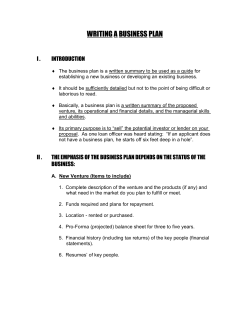




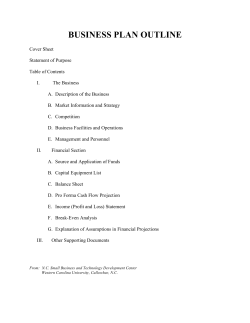

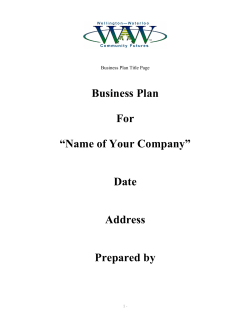



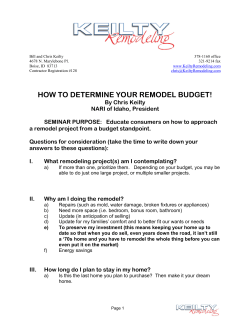





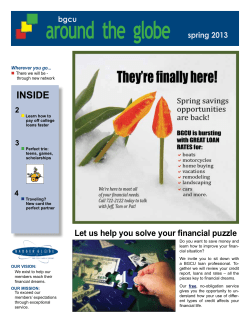
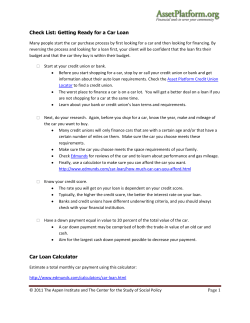

![-- FREE VERSION -- BUSINESS PLAN [Company Logo]](http://cdn1.abcdocz.com/store/data/000167608_1-42df28f9b0d5f3010b555b6dd3118db4-250x500.png)
